Thermonuclear Tokamak Startup
The popular Nuclear Nuclear News site writes about the launch (first plasma) of the ST40 tokamak, owned by Tokamak Energy, a privately held British company. The news is quite interesting, especially if you know the context, which I will try and set out.
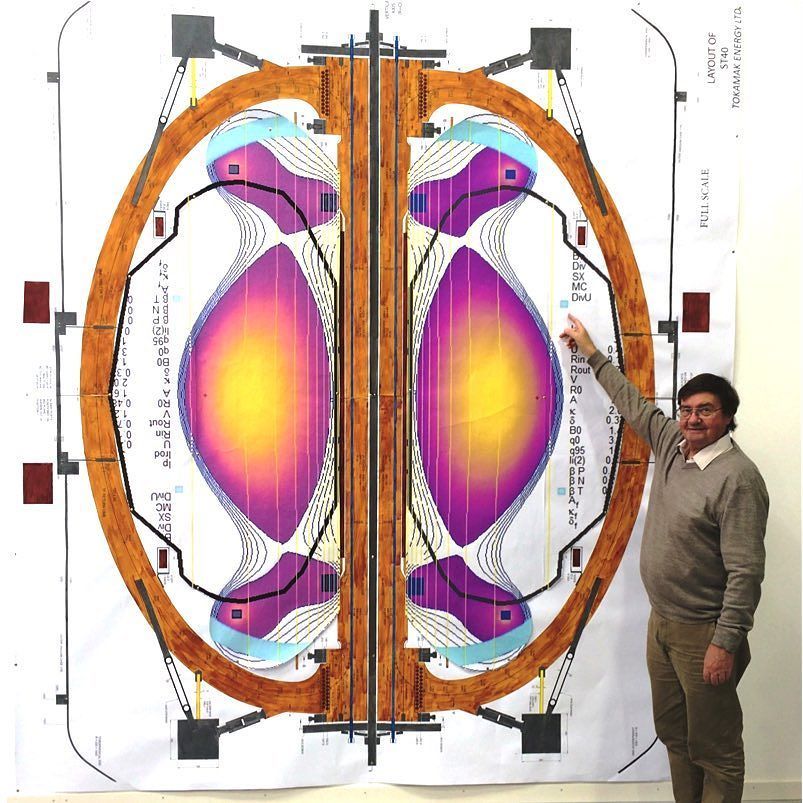
Founder of Tokamak Energy Alan Sykes near the ST-40 cut on a scale of 1 to 1.
Tokamak Energy (TE) was founded in 2009 (next to the largest in the world today, JET tokamak), and since 2012 has received funding (today the startup has collected $ 35 million) for the construction of a series of tokamaks leading to an energy reactor. Against the background of ITER worth 20+ billion dollars, not leading to a power reactor, does it look weird? Let's figure it out.
The main problem of thermonuclear fusion is not to get a thermonuclear reaction, but so that the reactor in which we conduct it is of reasonable size. Virtually any of the concept of fusion works, if you increase the size of the reactor to kilometers, and power - to terawatts, but such designs are not applicable in real life. The essence of the work of plasmists in the search for such configurations and sizes of thermonuclear plasma, in which its size will be minimal with a reasonable complication of the reactor design (for example, heating systems).
')
Video from Tokamak Energy about the "first plasma" ST40. In the frame - a tokamak vacuum chamber, with a heating system for firing, the magnetic system is not present. Beautiful green glow - glow discharge for cleaning the walls of the chamber, not directly related to thermonuclear plasma
Spherical tokamaks just allow you to take a step down in terms of the size of the plasma cord with the same fusion power, formally cheapens the reactor. The theoretical basis of this is clear from 1986 (when the first article was published), and experimentally confirmed in the 90s. I wrote more about this in a post about a new Russian tokamak , also spherical.

Assembly of the vacuum chamber ST40. At ITER, it would just look like, say, a container for storing technical water, no more :).
In fact, Tokamak Energy is trying to commercialize this discovery of plasmists twenty years ago. Many engineering challenges stand in the way of this, some of which seem insurmountable or, in any case, are not surmountable for reasonable money. That is why the news about moving forward TE evokes mixed feelings, because it is clear that all these successes will end at some point.
At present, in the TE asset, launch a very small tokamak (actually, a desktop) ST-25 and then convert it to high-temperature superconductors, achieving a record plasma retention in tokamak within 29 hours (true, plasma, very low temperature and density for thermonuclear settings ). The next tokamak, which was launched on April 28, is much more serious. So much so that it makes us believe that insurmountable engineering difficulties can be overcome.
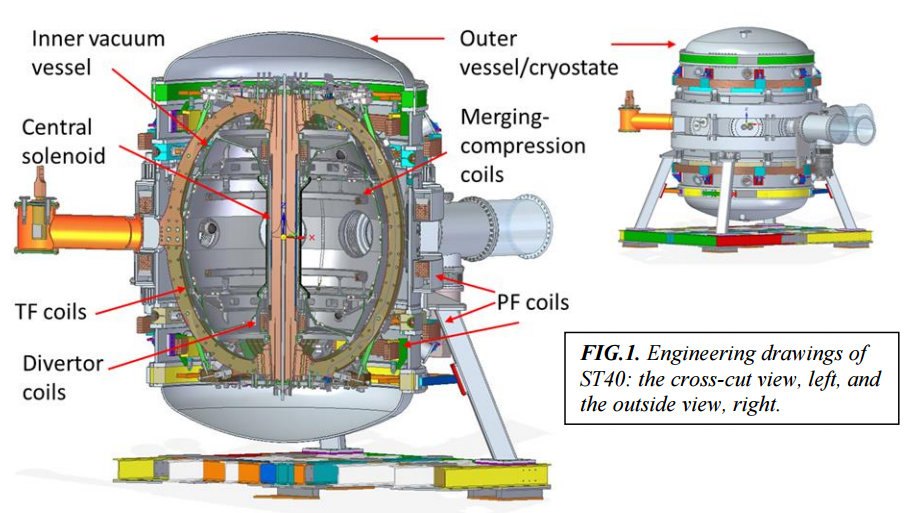
In the future, the tokamak design will be immersed in a large vacuum vessel for thermal insulation - a cryostat. Inside it is a copper magnetic system of toroidal and poloidal coils, inside which is a tokamak vacuum chamber. An important technical feature is the merging-compression coils, which solve the problem of insufficient volume in the central column for a central solenoid.
So, ST40. This is a purely research machine, which should be one of the intermediate stages on the way to the energy prototype ST185 (which according to the plan will be built in 2025, which is a very serious doubt about which at the end). Spherical tokamak with a plasma cord radius of only 40 cm, a vacuum chamber measuring 1.5x2.2 meters is a crumb on the background of serious cars. After full completion, it should reach plasma parameters with Q = 1 ... 2 (and therefore a temperature of 10 keV, also a record for such small sizes), where Q is the ratio of thermonuclear power to heating. Let me remind you that today the record Q = 1.2 for the JT-60U tokamak with a plasma volume is ten times more, and located close to ST40 JET, also with a plasma volume 40 times more, only Q = 0.7 at one time. In fact, if the calculated parameters of ST40 are confirmed, it will be an incredible breakthrough for tokamaks.
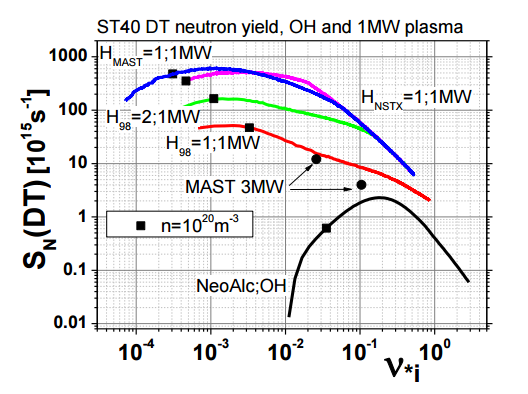
Simulation of the ST40 neutron yield for plasma DT by different methods. Recalculation from the parameters of the other spherical tokamak MAST gives about 3 megawatts of thermonuclear power at 2 megawatts of heating, i.e. Q ~ 1.5, but the result may be worse.
What exactly distinguishes the ST40 from its predecessors? This is a spherical tokamak with a fairly strong field of 3 Tesla (it should be noted - a record among the spherical tokamaks), as optimized as possible for obtaining high Q. High field here is an achievement in itself. The problem of spherical tokamaks is that physics requires having a central column of as small a diameter as possible (to bring the plasma shape closer to the sphere as much as possible), which means the minimum area for the inner arcs of toroidal coils and the central solenoid. The current of the toroidal coils determines the field strength, despite the fact that the current density can not be higher than certain parameters, that for copper, that for a superconducting system. The central solenoid, in turn, is needed for the primary pumping of plasma by energy, and its size is also rather strictly limited from below.


The copper conductors of the toroidal field coils and the central column. 24 D-shaped coils grouped by 3 (bottom photo on the left) in the first stage, when starting for 1 ... 10 seconds, a current of about 100 kA will be conducted
It turns out that engineering constraints dictate either a low field in a spherical tokamak ... or a rejection of the standard approach to launch. In ST40, a new method of starting plasma heating and formation of a ring current is used - compression and reconnection of magnetic lines. This phenomenon is responsible for solar flares, and is able to heat plasma very well. The effectiveness of this approach is not clear, and this is the first task of ST40 - to learn how to start a plasma current without using a central solenoid (a small CA in the ST40 design still remains to maintain a flat current profile during start-up, but its volume is about 10 times less than the classical scheme).
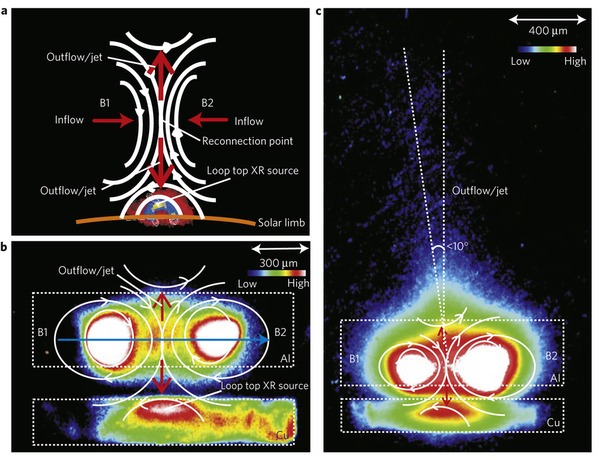
Magnetic reconnection is the phenomenon of a reconfiguration of the magnetic field, when two tubes of the oppositely directed field are “short-circuited” and disappear, releasing energy. In the picture, these are the outer tubes of the “inflow” domains, and the energy is released in the directions of the vertical arrows.
The second engineering solution in an attempt to break through the restrictions would be the use of a copper system cooled to liquid nitrogen temperature. This reduces the resistance of copper 20-30 times, and allows you to raise the current density tenfold. The trick that will allow the small ST40 to catch up with large expensive machines in terms of the Q parameter and thermonuclear power is quite a dead end - this solution does not allow you to go to the tokamak, which is running for more than 10 seconds. TE here are hoping for high-temperature superconductivity, but the required engineering density in the central column of current (at least 100 amperes per square millimeter) is quite difficult to achieve, given the volume occupied by electrical and temperature insulation, neutron protection, structural component, etc. For example, in the ITER toroidal magnets, the engineering current density is only 11 A / mm ^ 2. This is one of the most difficult obstacles to the spherical tokamak, and how Tokamak Energy will decide it is unknown.
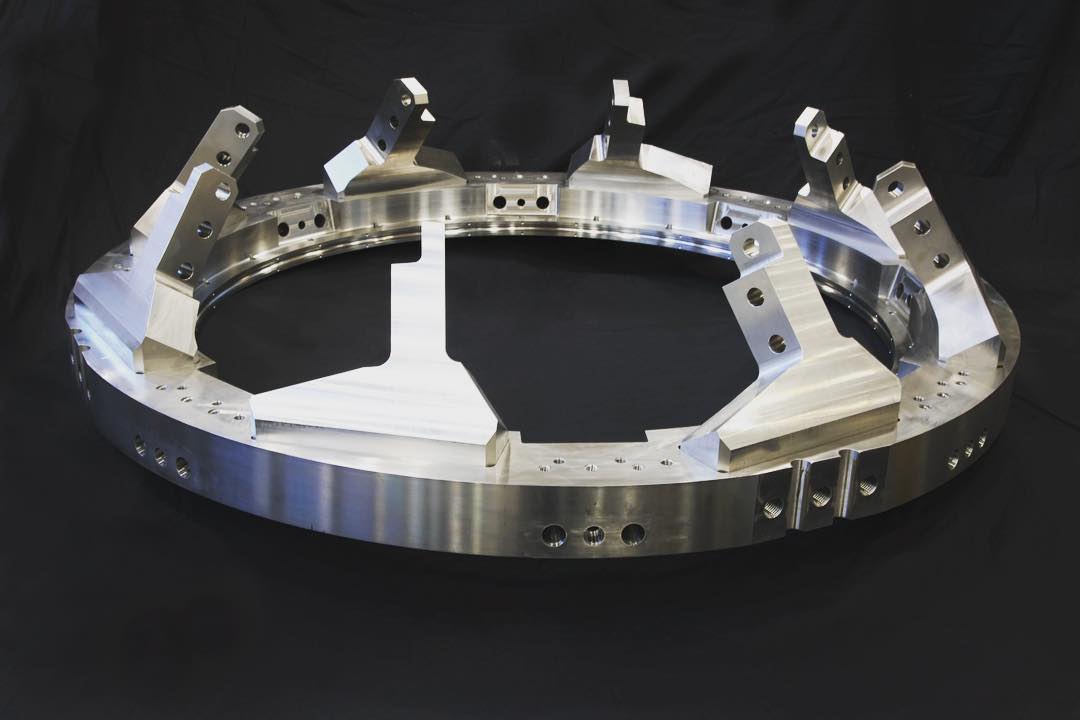
Ring for securing the compression coils-reconnection inside the ST40 vacuum chamber. One problem from the world of thermonuclear magnets — Tokamak Energy’s engineers have already encountered large deforming ponderomotive forces, but for an energy prototype these forces will grow by an order of magnitude.
As I said, this project causes mixed feelings. One of them is unconditional surprise and even delight at the parameters of a tiny thermonuclear installation, which in theory closes the belt with the most serious tokamaks with government funding of hundreds of millions of dollars. The second feeling is disappointment from reality.
In reality, the “launch” of the ST40 is just a set of vacuum and the cleaning of internal surfaces with a glow discharge in lithium plasma (beautiful green). The magnetic system has not yet been assembled and installed on the vacuum chamber even in the simplest configuration, although according to plans a year ago it should have happened at the turn of the 16/17 year. Before the records, plugging into the JET and JT-60U belts, the installation still has to undergo several serious upgrades (installing a cryostat around the tokamak, creating a cooling system for the magnets with liquid nitrogen, upgrading the magnet power supply system to ten times more stored energy, installing neutral beam injectors, etc. .) - at this rate of work, only these tasks can be delayed until 2025.

Although the ST40 vacuum chamber is not such a simple product, its complexity is much less than the entire installation, not to mention the subsequent superconducting “ST *”. So TE engineers are just at the beginning.
“Thermonuclear power”, about which we argue about Q, in the case of ST40 will also be slightly virtual, recalculated from the neutron output DD of the plasma (with which ST40 will actually work) to DT (however this conversion from the neutron power is done quite unambiguously) . This is due to the fact that working with tritium means a completely different installation class with years of obtaining a license for it from the nuclear regulator and most likely with the construction of a special complex of buildings. Perhaps, TE is already doing this work to obtain further nuclear licenses, if not for this, then for the next machine, but as long as it is not advertised in any way, it is not visible in the engineering solutions and campaign plans. Namely, the nuclear component of tokamaks is a kind of Everest, on which very few projects can climb - very difficult, very expensive and unsafe. The nuclear component ultimately determines the cost and engineering appearance of a power plant, and “forgetting” about it means forgetting about 50% of the complexity and complexity.
These thoughts smoothly lead us to a question to which I have no answer - who and why is investing money today in fusion startups around the world? The last decade has seen a clear boom in such projects - Tokamak Energy, Tri Alpha Energy , General Fusion , Helion Energy and others , despite the fact that the electricity market is depressed and the construction of new power plants of any type is unprofitable without subsidies, with the exception of developing countries. If Tri Alpha develops the idea of installing a neutron-free thermonuad that may not require licensing, and General Fusion hopes that the idea of a “low-tech” thermonuad will work, then for more or less traditional schemes it’s hard to imagine how to pay for it - just like that how difficult it is to imagine the payback of a “nuclear reactor to every home”, despite the engineering feasibility of such a facility.
Whether investors are still in the paradigm of the 60s ... 70s, or are they hoping for new markets (for example, replacing coal-fired power plants in pursuit of reducing CO2 emissions), or whether venture psychology makes them invest in any projects for wide markets (and the electricity market is still one of the largest). However, the fact remains that in the modern world there is money that makes it possible to test many “perpendicular” ideas in the gland, and perhaps one of them will give the first fusion energy even before the ITER reaches full power.
PS Photos from the Tokamak Energy instagram were used , an article about the engineering and physical basis of ST40 and on the physical “philosophy” of choosing the size of a tokamak .

Founder of Tokamak Energy Alan Sykes near the ST-40 cut on a scale of 1 to 1.
Tokamak Energy (TE) was founded in 2009 (next to the largest in the world today, JET tokamak), and since 2012 has received funding (today the startup has collected $ 35 million) for the construction of a series of tokamaks leading to an energy reactor. Against the background of ITER worth 20+ billion dollars, not leading to a power reactor, does it look weird? Let's figure it out.
The main problem of thermonuclear fusion is not to get a thermonuclear reaction, but so that the reactor in which we conduct it is of reasonable size. Virtually any of the concept of fusion works, if you increase the size of the reactor to kilometers, and power - to terawatts, but such designs are not applicable in real life. The essence of the work of plasmists in the search for such configurations and sizes of thermonuclear plasma, in which its size will be minimal with a reasonable complication of the reactor design (for example, heating systems).
')
Video from Tokamak Energy about the "first plasma" ST40. In the frame - a tokamak vacuum chamber, with a heating system for firing, the magnetic system is not present. Beautiful green glow - glow discharge for cleaning the walls of the chamber, not directly related to thermonuclear plasma
Spherical tokamaks just allow you to take a step down in terms of the size of the plasma cord with the same fusion power, formally cheapens the reactor. The theoretical basis of this is clear from 1986 (when the first article was published), and experimentally confirmed in the 90s. I wrote more about this in a post about a new Russian tokamak , also spherical.

Assembly of the vacuum chamber ST40. At ITER, it would just look like, say, a container for storing technical water, no more :).
In fact, Tokamak Energy is trying to commercialize this discovery of plasmists twenty years ago. Many engineering challenges stand in the way of this, some of which seem insurmountable or, in any case, are not surmountable for reasonable money. That is why the news about moving forward TE evokes mixed feelings, because it is clear that all these successes will end at some point.
At present, in the TE asset, launch a very small tokamak (actually, a desktop) ST-25 and then convert it to high-temperature superconductors, achieving a record plasma retention in tokamak within 29 hours (true, plasma, very low temperature and density for thermonuclear settings ). The next tokamak, which was launched on April 28, is much more serious. So much so that it makes us believe that insurmountable engineering difficulties can be overcome.

In the future, the tokamak design will be immersed in a large vacuum vessel for thermal insulation - a cryostat. Inside it is a copper magnetic system of toroidal and poloidal coils, inside which is a tokamak vacuum chamber. An important technical feature is the merging-compression coils, which solve the problem of insufficient volume in the central column for a central solenoid.
So, ST40. This is a purely research machine, which should be one of the intermediate stages on the way to the energy prototype ST185 (which according to the plan will be built in 2025, which is a very serious doubt about which at the end). Spherical tokamak with a plasma cord radius of only 40 cm, a vacuum chamber measuring 1.5x2.2 meters is a crumb on the background of serious cars. After full completion, it should reach plasma parameters with Q = 1 ... 2 (and therefore a temperature of 10 keV, also a record for such small sizes), where Q is the ratio of thermonuclear power to heating. Let me remind you that today the record Q = 1.2 for the JT-60U tokamak with a plasma volume is ten times more, and located close to ST40 JET, also with a plasma volume 40 times more, only Q = 0.7 at one time. In fact, if the calculated parameters of ST40 are confirmed, it will be an incredible breakthrough for tokamaks.

Simulation of the ST40 neutron yield for plasma DT by different methods. Recalculation from the parameters of the other spherical tokamak MAST gives about 3 megawatts of thermonuclear power at 2 megawatts of heating, i.e. Q ~ 1.5, but the result may be worse.
What exactly distinguishes the ST40 from its predecessors? This is a spherical tokamak with a fairly strong field of 3 Tesla (it should be noted - a record among the spherical tokamaks), as optimized as possible for obtaining high Q. High field here is an achievement in itself. The problem of spherical tokamaks is that physics requires having a central column of as small a diameter as possible (to bring the plasma shape closer to the sphere as much as possible), which means the minimum area for the inner arcs of toroidal coils and the central solenoid. The current of the toroidal coils determines the field strength, despite the fact that the current density can not be higher than certain parameters, that for copper, that for a superconducting system. The central solenoid, in turn, is needed for the primary pumping of plasma by energy, and its size is also rather strictly limited from below.


The copper conductors of the toroidal field coils and the central column. 24 D-shaped coils grouped by 3 (bottom photo on the left) in the first stage, when starting for 1 ... 10 seconds, a current of about 100 kA will be conducted
It turns out that engineering constraints dictate either a low field in a spherical tokamak ... or a rejection of the standard approach to launch. In ST40, a new method of starting plasma heating and formation of a ring current is used - compression and reconnection of magnetic lines. This phenomenon is responsible for solar flares, and is able to heat plasma very well. The effectiveness of this approach is not clear, and this is the first task of ST40 - to learn how to start a plasma current without using a central solenoid (a small CA in the ST40 design still remains to maintain a flat current profile during start-up, but its volume is about 10 times less than the classical scheme).

Magnetic reconnection is the phenomenon of a reconfiguration of the magnetic field, when two tubes of the oppositely directed field are “short-circuited” and disappear, releasing energy. In the picture, these are the outer tubes of the “inflow” domains, and the energy is released in the directions of the vertical arrows.
The second engineering solution in an attempt to break through the restrictions would be the use of a copper system cooled to liquid nitrogen temperature. This reduces the resistance of copper 20-30 times, and allows you to raise the current density tenfold. The trick that will allow the small ST40 to catch up with large expensive machines in terms of the Q parameter and thermonuclear power is quite a dead end - this solution does not allow you to go to the tokamak, which is running for more than 10 seconds. TE here are hoping for high-temperature superconductivity, but the required engineering density in the central column of current (at least 100 amperes per square millimeter) is quite difficult to achieve, given the volume occupied by electrical and temperature insulation, neutron protection, structural component, etc. For example, in the ITER toroidal magnets, the engineering current density is only 11 A / mm ^ 2. This is one of the most difficult obstacles to the spherical tokamak, and how Tokamak Energy will decide it is unknown.

Ring for securing the compression coils-reconnection inside the ST40 vacuum chamber. One problem from the world of thermonuclear magnets — Tokamak Energy’s engineers have already encountered large deforming ponderomotive forces, but for an energy prototype these forces will grow by an order of magnitude.
As I said, this project causes mixed feelings. One of them is unconditional surprise and even delight at the parameters of a tiny thermonuclear installation, which in theory closes the belt with the most serious tokamaks with government funding of hundreds of millions of dollars. The second feeling is disappointment from reality.
In reality, the “launch” of the ST40 is just a set of vacuum and the cleaning of internal surfaces with a glow discharge in lithium plasma (beautiful green). The magnetic system has not yet been assembled and installed on the vacuum chamber even in the simplest configuration, although according to plans a year ago it should have happened at the turn of the 16/17 year. Before the records, plugging into the JET and JT-60U belts, the installation still has to undergo several serious upgrades (installing a cryostat around the tokamak, creating a cooling system for the magnets with liquid nitrogen, upgrading the magnet power supply system to ten times more stored energy, installing neutral beam injectors, etc. .) - at this rate of work, only these tasks can be delayed until 2025.

Although the ST40 vacuum chamber is not such a simple product, its complexity is much less than the entire installation, not to mention the subsequent superconducting “ST *”. So TE engineers are just at the beginning.
“Thermonuclear power”, about which we argue about Q, in the case of ST40 will also be slightly virtual, recalculated from the neutron output DD of the plasma (with which ST40 will actually work) to DT (however this conversion from the neutron power is done quite unambiguously) . This is due to the fact that working with tritium means a completely different installation class with years of obtaining a license for it from the nuclear regulator and most likely with the construction of a special complex of buildings. Perhaps, TE is already doing this work to obtain further nuclear licenses, if not for this, then for the next machine, but as long as it is not advertised in any way, it is not visible in the engineering solutions and campaign plans. Namely, the nuclear component of tokamaks is a kind of Everest, on which very few projects can climb - very difficult, very expensive and unsafe. The nuclear component ultimately determines the cost and engineering appearance of a power plant, and “forgetting” about it means forgetting about 50% of the complexity and complexity.
These thoughts smoothly lead us to a question to which I have no answer - who and why is investing money today in fusion startups around the world? The last decade has seen a clear boom in such projects - Tokamak Energy, Tri Alpha Energy , General Fusion , Helion Energy and others , despite the fact that the electricity market is depressed and the construction of new power plants of any type is unprofitable without subsidies, with the exception of developing countries. If Tri Alpha develops the idea of installing a neutron-free thermonuad that may not require licensing, and General Fusion hopes that the idea of a “low-tech” thermonuad will work, then for more or less traditional schemes it’s hard to imagine how to pay for it - just like that how difficult it is to imagine the payback of a “nuclear reactor to every home”, despite the engineering feasibility of such a facility.
Whether investors are still in the paradigm of the 60s ... 70s, or are they hoping for new markets (for example, replacing coal-fired power plants in pursuit of reducing CO2 emissions), or whether venture psychology makes them invest in any projects for wide markets (and the electricity market is still one of the largest). However, the fact remains that in the modern world there is money that makes it possible to test many “perpendicular” ideas in the gland, and perhaps one of them will give the first fusion energy even before the ITER reaches full power.
PS Photos from the Tokamak Energy instagram were used , an article about the engineering and physical basis of ST40 and on the physical “philosophy” of choosing the size of a tokamak .
Source: https://habr.com/ru/post/403535/
All Articles